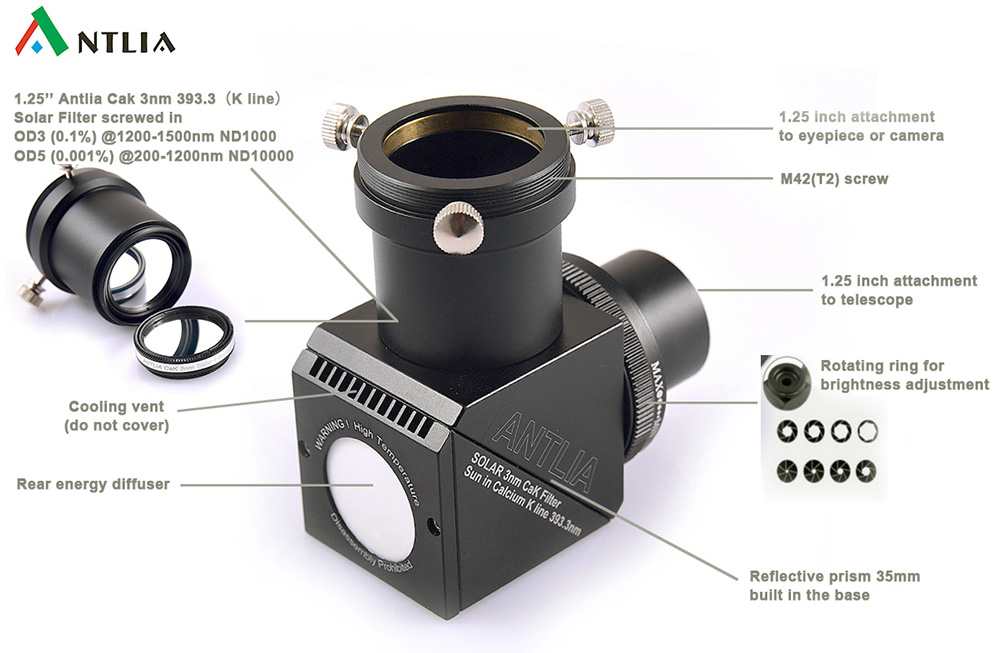About this product
Model: antlia_cak_3nm_solar_wedge_125
Antlia Imaging 1.25" Herschel Wedge with 35mm Prism & CaK 3nm Solar Filter
This Antlia Herschel Solar Wedge replaces the standard prism diagonal at the rear of refractor telescopes to enable imaging of solar granulation and sunspots. The Herschel Wedge design provides sharper, higher-contrast images than regular solar filters.
Incorporates an Antlia 3nm narrow bandpass filter at the Calcium II K-Line, centred on 393.3nm, and mounted in a standard 1.25’’ holder.
Image brightness is reduced to a safe level and can be conveniently increased or decreased using a control ring with aperture blades, similar to that used in camera lenses.
Features a CNC-machined body and fully multicoated optical components to minimise internal reflections and stray light.
Unlike some other solar wedge designs, which can become hot, the Antlia Imaging Herschel Wedge directs energy into an extra thick Polycrystalline Ceramic diffuser plate at the rear of the Wedge. In addition, cooling vents above the ceramic plate facilitate efficient cooling.
Features
- Herschel 35mm prism
- Integrated ceramic heat dispersion diffuser
- Sharp CaK 3nm 393.3nm solar filter screwed into eyepiece holder base
- High-resolution imaging of granulation, sunspots, and other features
- Includes a brightness control, a solar finder and an effective heat dissipation system
- Anti Reflection (AR) coated prism and solar filter
- High blocking specification to reject solar heat ingress
- Sturdy CNC machined construction

CaK 3nm 393.3nm Filter Specifications
The Antlia Solar Wedge prism and internal CaK solar filter are made of a heat-resistant double-polished substrate. Antlia CaK 393.3nm solar filter uses the most advanced multicoatings to produce a sharp 3nm narrow bandpass, designed to maximise contrast for high-resolution imaging of sunspots, solar surface granulation and other features that are prominent in CaK light.
A high blocking specification of OD5 (0.001%) between 200-1200nm wavelengths and OD3 (0.1%) between 1200-1500nm wavelengths delivers superb resolution for imaging with the Antlia CaK 3nm solar filter.
It should be noted that the bandpass for CaK (393nm) makes solar features almost invisible to human vision because of the eye's low sensitivity and poor resolving ability at the CaK frequency. Hence, the Antlia Solar Wedge with CaK filter is not recommended for visual observation. It is designed for imaging with cameras that have spectral responses well beyond human vision.
IMPORTANT:
Never look into the sun with the K-Line filter alone, although you don’t perceive it, there is a lot of harmful UV radiation entering your eye.
The Antlia Herschel Wedge is intended for imaging ONLY. It is NOT suitable for visual observation.
It is not intended for solar prominence imaging or visual.
Must only be used with refractor telescopes to avoid damage to the unit.
Not suitable for use with Petzval or other telescope designs with a rear lens element positioned close to the focuser drawtube.
The refractor telescope aperture must not be larger than 120mm or have a focal-ratio value less than F5.5.
Never use the Solar wedge without the supplied narrowband filter. Otherwise, irreparable eye damage can result.
Disassembly is prohibited and voids the warranty. Any repair/returns/exchange for this item are not accepted if it has been disassembled.
Customer reviews
| Average Rating (1 Review): | |
23 August 2023 | Tim
I bought this because the Lunt module Ian sold me nearly 10 years ago died of old age.
It is nicely engineered and documented and comes in a dinky miniature flight case.
My initial thoughts were very negative; The results looked pretty much the same as I'd got in white light. I tried again this week and it looked pretty dreadful too. I did persevere and eventually using software got a bit of plage to show its face. Probably I should have used a monochrome camera and I'll try that shortly but I am not massively hopeful.
The camera type diaphragm I assume is some kind of jest.
FAQ
Please fill in the form below to ask a question.